Potential Drawbacks
While medical injection molding offers numerous benefits, such as high precision, scalability, and cost-effectiveness, it is not without its potential drawbacks. Understanding these limitations is crucial for manufacturers and healthcare professionals when deciding whether this manufacturing process is suitable for a particular medical device or component.
High Initial Tooling Costs
One of the most significant drawbacks of medical injection molding is the high initial cost of creating molds and tooling. Precision mold medical requires specialized, custom-built molds that are expensive to design and produce. For small production runs or when developing new medical devices, the upfront costs can be prohibitively high. This can make the process less cost-effective for low-volume production, especially for startups or companies developing prototype medical devices.
However, FUJIU Medical Injection Mold, with its expertise and efficient processes, helps mitigate these costs by offering cost-effective solutions for both small and large-scale production. The long-term benefits of injection molding, including lower per-unit costs for high-volume production, often outweigh the initial investment for larger-scale manufacturing. The ability to mass-produce components with consistent quality and performance, as FUJIU ensures, may justify the initial tooling expenses in the long run.
Material Limitations
While medical injection molding can use a variety of materials, not all materials are suitable for every medical application. Some advanced materials required for specialized applications, such as biodegradable polymers or highly specific biocompatible materials, may not be compatible with certain injection molding processes. Precision mold medical requires careful material selection, as using an inappropriate material can result in compromised product quality or failure to meet regulatory standards.
Additionally, some materials used in injection molding may not provide the necessary characteristics for specific medical applications, such as high chemical resistance or heat resistance. The material limitations can impact the performance of the final product and its suitability for particular medical environments or applications, such as implants or surgical instruments.
Complexity in Design and Modifications
The complexity of precision mold medical can sometimes lead to challenges in the design and modification process. Medical components often require intricate details, such as micro holes, thin walls, or multi-material structures, which can complicate the mold design. Adjustments to the design during the molding process can be difficult and time-consuming, requiring new molds or modifications to existing ones.
While injection molding is ideal for mass production, making changes to the design or mold during the production process can be costly and may lead to delays. Any changes required after the tooling has been created can incur additional costs and require significant time for redesigning or retooling.
Risk of Defects and Inconsistencies
While medical injection molding is known for its high precision, the process is not immune to defects or inconsistencies. Factors such as improper material flow, inadequate cooling, or mold defects can lead to quality control issues, such as warping, surface imperfections, or dimensional inaccuracies. These defects are particularly critical in the medical industry, where components must meet stringent safety and functionality standards.
For example, medical devices that require perfect fitment or precise functionality, such as implants, diagnostic tools, or surgical instruments, can suffer from performance issues if there are defects in the molding process. Continuous monitoring and quality assurance are required to identify and correct any defects early on.
Environmental Concerns
While many materials used in medical injection molding are recyclable, the process itself can generate a significant amount of waste. The injection molding process often results in excess material, which may not always be recyclable or reusable. Additionally, certain polymers used in medical molding, such as polycarbonate or polypropylene, may not be easily biodegradable, contributing to plastic waste concerns.
To address these concerns, manufacturers can use more sustainable materials and improve waste management practices, but the environmental impact of medical injection molding remains an issue, especially as the demand for plastic medical components continues to rise globally.
Production Time for Complex Parts
For simple, high-volume components, medical injection molding can be an efficient and fast process. However, when creating highly complex parts with intricate designs or multi-material features, the production time can increase. Precision mold medical often requires more advanced equipment and additional steps in the molding process, which can lengthen the time required to produce a part.
This may be particularly challenging for companies needing rapid prototyping or quick turnaround times, as the complexities of the molds and the precision required may make the process less time-efficient.
Regulatory Compliance and Documentation
The medical industry is heavily regulated, and all medical devices must meet strict standards to ensure their safety and effectiveness. For manufacturers using medical injection molding, complying with regulations such as FDA guidelines, ISO standards, and CE certifications is essential. This involves maintaining meticulous documentation throughout the entire manufacturing process, including material certifications, testing protocols, and batch records.
The complexity and time-consuming nature of meeting regulatory requirements for precision mold medical parts can pose challenges, especially in ensuring that the product meets all necessary certifications for safety, quality, and performance. Additionally, the ongoing oversight required for compliance can add to production costs and time.
Limited Design Flexibility Once Molds Are Created
Once the mold for a medical component is created, it is not easy to change the design. Any modifications made after the mold is created often require significant rework or a completely new mold, which can be costly and time-consuming. This lack of flexibility can be particularly problematic for manufacturers who need to make adjustments or improvements to the design after initial production runs.
In the medical industry, where continuous innovation and design improvements are common, this limitation can lead to delays and added costs, especially in fast-paced development environments.




